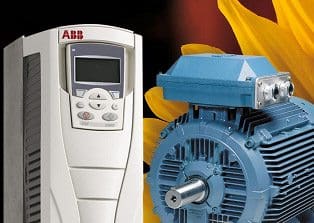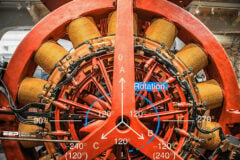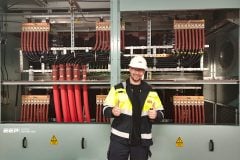Potential for major energy savings

With electric motors accounting for an estimated 65 percent of industrial energy use, any increases in efficiency clearly provide the potential for major savings. The energy consumption of electric motors can be reduced in two main ways – by implementing efficient speed control and by increasing the efficiency of the motors themselves.
Variable speed drives (VSD) are by far the most effective method of controlling motor speeds. In practice, however, control is often still implemented with throttling valves in pump systems, vanes in fan applications, or gears or belt drives in rotating machinery. Belt drives, gearboxes and hydraulic couplings all add to the inefficiency of the system, and require the motor to run at full speed all of the time.
In addition, mechanical drives can be noisy as well as difficult to service, as they are situated between the motor and the driven machinery.
Half speed for only a quarter of the energy
In pump and fan applications, VSDs can cut energy bills by as much as 60 percent. A pump or fan running at half speed consumes only one quarter as much energy as a unit running at full speed.
As a small reduction in speed can make a big difference in energy consumption, and because many pump and fan systems run at less than full capacity for much of the time, VSDs can produce huge savings. This is particularly so when compared to motors that are continuously running at full speed, even though motors have improved in efficiency by an average of 3 percent over the last decade.
It has been estimated that AC drives supplied by ABB over the past ten years for the speed control of pumps and fans have reduced electricity consumption by around 160 TWh per year worldwide.
Regulating motor speeds has the added benefit that production increases can easily be accommodated without the need for extra investment, as AC drives can easily manage speed increases of 5–20 percent. By matching the performance of the motor to the needs of the process, drives can produce major savings when compared to the wasteful practice of running the motor at full speed against a restriction to modulate output. In an ideal world, energy would be applied with pinpoint accuracy when and where it was needed, and no energy would be wasted.
Despite the obvious energy saving advantages, 97 percent of all motors in applications under 2.2 kW have no form of speed control at all. This corresponds to some 37 million industrial motors sold annually worldwide. This might have been understandable in the past, as a small drive cost in the region of $500 (400 euros) per kW. Drives across the range have become smaller and cheaper over the past few years, however, and now start at around $150 (100 euros) per kW.
This can make investment in a VSD a viable proposition on energy grounds alone. In addition, the new generation of drives is smaller and so installation might be possible in places where space constraints were an issue in the past. The latest drives are also more energy efficient than their predecessors. ABB is leading the way in developing drive technology, with state-of-the-art control techniques such as direct torque control (DTC). A feature of DTC which contributes directly to energy efficiency is motor flux optimization, which greatly improves the efficiency of the total drive (the controller and the motor), especially in pump and fan applications.
The drives themselves are becoming leaner too, not only smaller in size but more energy efficient to manufacture, with smaller circuit boards and enclosures made of recyclable plastic.
Subsidies for high efficiency motors
In many countries financial incentives are now available to encourage investment in high efficiency motors. The Danish Energy Agency is one of the leading organizations in the field.
It has published a list of high efficiency motors and offers a subsidy of $10 (7.70 euros) per kilowatt for both new and replacement units purchased from the list. This scheme is promoted direct to the 4,000 largest motor users.
The USA and Canada have introduced the Energy Policy and Conservation Act (EPAct). Among other legislation to improve the environment, this specifically targets motors from 0.75 to 150 kW as prime candidates for improvement. A scheme similar to the Danish one has been adopted, with a published list of high efficiency motors and reduced electricity tariffs for users of the listed products.
The US Department of Energy also requires the efficiency rating to be indicated on the motor nameplate, the energy efficiency to be displayed prominently in all literature and marketing material, and the inclusion of other markings to facilitate the enforcement of energy efficiency standards. Failure to comply with these requirements results in severe penalties.










